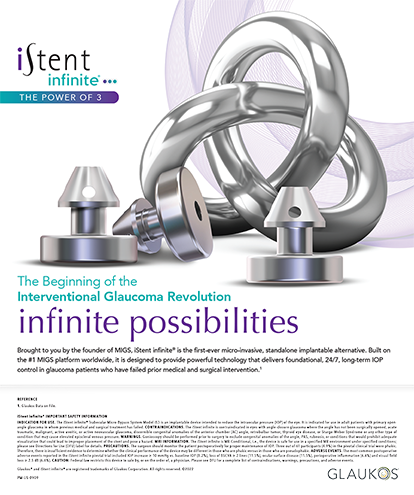Although the newest presbyopia-correcting IOLs seem to have a higher success rate than previous versions, any surgeon implanting these lenses will eventually encounter a patient who does not achieve the level of vision expected. The case presented in this article provides an example.
CASE PRESENTATION
A 74-year-old woman underwent bilateral cataract surgery with in-the-bag placement of Crystalens HD IOLs (Bausch + Lomb, Rochester, NY). I targeted a slight amount of myopia for the left, nondominant eye. The patient did quite well for the first month, reaching an uncorrected binocular visual acuity of 20/25 and J2.
At her 3-month visit, her binocular visual acuity was 20/20 and J6. Her right eye had unintentionally become the one for reading. Her manifest refraction was -2.75 +1.00 X 30 OD and -0.75 +0.75 X 180 OS. The patient was becoming dissatisfied with her distance vision but preferred to have glasses prescribed rather than consider a LASIK enhancement.
Six months postoperatively, the visual acuity of the patient’s left eye was unchanged. The UCVA and BCVA in her right eye had slipped to 20/80 and 20/40, respectively, leaving her highly dissatisfied. An examination found a clear posterior capsule but bulging of the inferior iris secondary to IOL touch in her right eye. Imaging (Visante OCT; Carl Zeiss Meditec, Inc., Dublin, CA) demonstrated significant tilting of the IOL in the patient’s right eye consistent with the entity known as Z syndrome (Figure 1).
OPTIONS
Methods for potentially resolving Z syndrome using specialized YAG laser capsulotomy techniques have been described. If unsuccessful, these approaches increase the risk of explanting the IOL. After a lengthy discussion, the patient decided to undergo intraocular surgical intervention. My hope was to expand the bag with an ophthalmic viscosurgical device (OVD) in order to break fibrotic bands and allow the IOL to relax back into position. I could then place a capsular tension ring to maintain capsular expansion postoperatively.
SURGICAL COURSE
I selected a dispersive OVD (3% sodium hyaluronate, 4% chondroitin sulfate), because the agent’s dispersive nature would allow for greater extension of the capsular bag with less risk of focal pressure compared with a cohesive OVD. Because of the likelihood that the haptics of the IOL had become strongly fibrosed into the bag, I placed the OVD cannula directly over their bulbous ends while injecting the OVD in order to free the haptics completely. After I had lysed all of the fibrotic adhesions, it became apparent that one of the haptics had a mind of its own, as it continued to vault anteriorly. I injected the largest available capsular tension ring to further expand the capsular bag, but the IOL continued to vault forward. At this point, I decided to explant the IOL and replace it with a monofocal lens set for distance.
I brought the accommodating IOL into the anterior chamber and cut the haptics free with intraocular scissors (MicroSurgical Technology, Redmond, WA). I bisected the IOL’s optic in a similar fashion and removed all four pieces. A single-piece hydrophobic acrylic IOL placed in the capsular bag centered well and remained planar.
OUTCOME
Postoperatively, the patient’s vision normalized. Her uncorrected distance vision at 1 week measured 20/20 and has remained unchanged.
DISCUSSION
Z syndrome is unique to the hinged haptic design of the Crystalens IOL. As fibrosis of the capsular bag occurs postoperatively, the lens’ haptics can become compressed enough to cause one of them to vault anteriorly, significantly tilting the lens and inducing astigmatism. More common, however, is a progressive anterior displacement of the optic, resulting in progressively worsening myopia.
Management requires a detailed discussion with the patient regarding realistic expectations. It certainly would be possible to explant the IOL and replace it with a multifocal IOL in order to maintain some near vision. In this case, the patient was perfectly content to wear readers.
Regarding explantation, it is not absolutely necessary to remove both the haptics and the optic. If fibrosis of the haptics were too severe to permit their removal without damage to the capsular bag or zonules, one could sever the haptics and leave them fibrosed into the bag’s periphery. The secondary IOL could then be placed posterior or anterior to both of the remaining haptics to avoid tilting of the lens.
A video of this case is available at http://eyetube.net/?v=pahoh.
Robert J. Cionni, MD, is the medical director of The Eye Institute of Utah in Salt Lake City, and he is an adjunct clinical professor at the Moran Eye Center of the University of Utah in Salt Lake City. He is a consultant to Alcon Laboratories, Inc. Dr. Cionni may be reached at (801) 266-2283.


